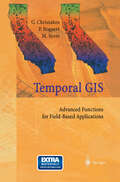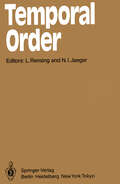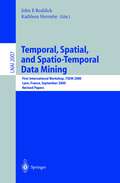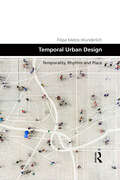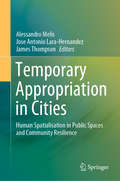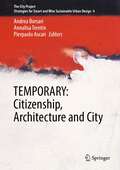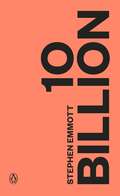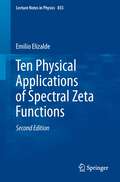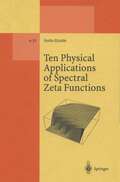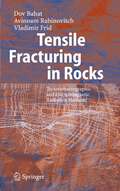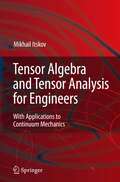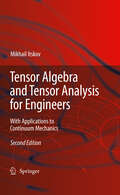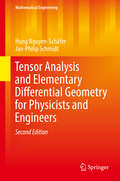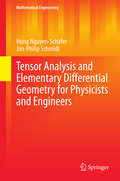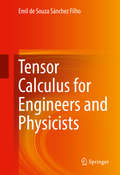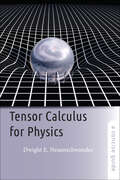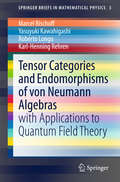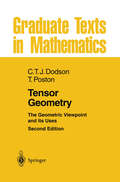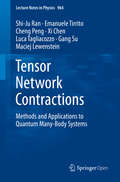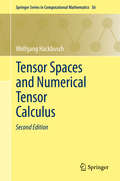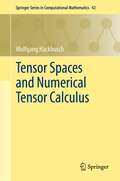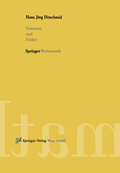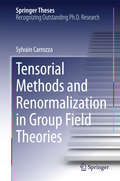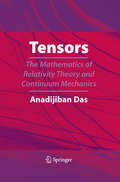- Table View
- List View
Temporal GIS: Advanced Functions for Field-Based Applications
by George Christakos Patrick Bogaert Marc SerreTemporal Order: Proceedings of a Symposium on Oscillations in Heterogeneous Chemical and Biological Systems, University of Bremen, September 17–22, 1984 (Springer Series in Synergetics #29)
by L. Rensing N. I. JaegerThis volume contains the lectures and contributions presented at the International Symposium on Temporal Order held in Bremen, September 17-22, 1984. Temporal order, such as a more or less regularly repeated temporal sequence of events, can evol ve in open systems far removed from equi 1 i bri um. Progress duri ng the last decade in the analysis and the modelling of this complex phenomenon in both biological and chemical systems gave rise to the idea of a joint conference. The purpose of the symposium was to stimulate future work by enhancing the exchange of experimental and theoretical results between neighbouring disciplines. Theoretical work in general, and mathematical models in particular, provided the basis for a mutual discussion and, thus, helped to overcome difficulties in under standing the results of different experimental fields. Chemical systems, for examp le, are more rigorously controllable through their experimental conditions in com parison to biological systems, which maintain highly effective autonomous control against environmental influences. Therefore, different states such as bistability, oscillations and chaos can be defined and, hence, described better in chemical sy stems. Chemical systems may thus provide some insights into functional structures that also exist in more complex biological systems.
Temporal, Spatial, and Spatio-Temporal Data Mining: First International Workshop TSDM 2000 Lyon, France, September 12, 2000 Revised Papers (Lecture Notes in Computer Science #2007)
by John F. Roddick Kathleen HornsbyThis volume contains updated versions of the ten papers presented at the First International Workshop on Temporal, Spatial and Spatio-Temporal Data Mining (TSDM 2000) held in conjunction with the 4th European Conference on Prin- ples and Practice of Knowledge Discovery in Databases (PKDD 2000) in Lyons, France in September, 2000. The aim of the workshop was to bring together experts in the analysis of temporal and spatial data mining and knowledge discovery in temporal, spatial or spatio-temporal database systems as well as knowledge engineers and domain experts from allied disciplines. The workshop focused on research and practice of knowledge discovery from datasets containing explicit or implicit temporal, spatial or spatio-temporal information. The ten original papers in this volume represent those accepted by peer review following an international call for papers. All papers submitted were refereed by an international team of data mining researchers listed below. We would like to thank the team for their expert and useful help with this process. Following the workshop, authors were invited to amend their papers to enable the feedback received from the conference to be included in the ?nal papers appearing in this volume. A workshop report was compiled by Kathleen Hornsby which also discusses the panel session that was held.
Temporal Urban Design: Temporality, Rhythm and Place (Design and the Built Environment)
by Filipa Matos WunderlichTemporal Urban Design: Temporality, Rhythm and Place examines an alternative design approach, focusing on the temporal aesthetics of urban places and the importance of the sense of time and rhythm in the urban environment. The book departs from concerns on the acceleration of cities, its impact on the urban quality of life and the liveability of urban spaces, and questions on what influences the sense of time, and how it expresses itself in the urban environment. From here, it poses the questions: what time is this place and how do we design for it? It offers a new aesthetic perspective akin to music, brings forward the methodological framework of urban place-rhythmanalysis, and explores principles and modes of practice towards better temporal design quality in our cities. The book demonstrates that notions of time have long been intrinsic to planning and urban design research agendas and, whilst learning from philosophy, urban critical theory, and both the natural and social sciences debate on time, it argues for a shift in perspective towards the design of everyday urban time and place timescapes. Overall, the book explores the value of the everyday sense of time and rhythmicity in the urban environment, and discusses how urban designers can understand, analyse and ultimately play a role in the creation of temporally unique, both sensorial and affective, places in the city. The book will be of interest to urban planners, designers, landscape architects and architects, as well as urban geographers, and all those researching within these disciplines. It will also interest students of planning, urban design, architecture, urban studies, and of urban planning and design theory.
Temporal Urban Design: Temporality, Rhythm and Place (Design and the Built Environment)
by Filipa Matos WunderlichTemporal Urban Design: Temporality, Rhythm and Place examines an alternative design approach, focusing on the temporal aesthetics of urban places and the importance of the sense of time and rhythm in the urban environment. The book departs from concerns on the acceleration of cities, its impact on the urban quality of life and the liveability of urban spaces, and questions on what influences the sense of time, and how it expresses itself in the urban environment. From here, it poses the questions: what time is this place and how do we design for it? It offers a new aesthetic perspective akin to music, brings forward the methodological framework of urban place-rhythmanalysis, and explores principles and modes of practice towards better temporal design quality in our cities. The book demonstrates that notions of time have long been intrinsic to planning and urban design research agendas and, whilst learning from philosophy, urban critical theory, and both the natural and social sciences debate on time, it argues for a shift in perspective towards the design of everyday urban time and place timescapes. Overall, the book explores the value of the everyday sense of time and rhythmicity in the urban environment, and discusses how urban designers can understand, analyse and ultimately play a role in the creation of temporally unique, both sensorial and affective, places in the city. The book will be of interest to urban planners, designers, landscape architects and architects, as well as urban geographers, and all those researching within these disciplines. It will also interest students of planning, urban design, architecture, urban studies, and of urban planning and design theory.
Temporary Appropriation in Cities: Human Spatialisation in Public Spaces and Community Resilience
by Alessandro Melis Jose Antonio Lara-Hernandez James ThompsonThis book conceptualises and illustrates temporary appropriation as an urban phenomenon, exploring its contributions to citizenship, urban social sustainability and urban health. It explains how some forms of appropriation can be subversive, existing in a grey area between legal and illegal activities in the city. The book explores the complex and the multi-scalar nature of temporary appropriation, and touches on its relationship to issues such as: sustainability and building re-use; culture; inclusivity, including socio-spatial inclusion; streetscape design; homelessness; and regulations controlling the use of public spaces. The book focuses on temporary appropriation as a necessity of adapting human needs in a city, highlighting the flexibility that is needed within urban planning and the further research that should be undertaken in this area. The book utilises case studies of Auckland, Algiers and Mexico City, and other cities with diverse cultural and historical backgrounds, to explore how planning, design and development can occur whilst maintaining community diversity and resilience. Since urban populations are certain to grow further, this is a key topic for understanding urban dynamics, and this book will be of interest to academics and practitioners alike.
TEMPORARY: Citizenship, Architecture and City (The City Project #4)
by Andrea Borsari Annalisa Trentin Pierpaolo AscariThis book offers a comprehensive overview of forces shaping urban renewal and the sustainable and inclusive transformation of contemporary cities. It discusses temporariness and uncertainty of citizenship, participation, and inclusion, as well as the energy and digital transformation, merging different perspectives, such as the social, philosophical, economic, and architectural ones. Based on revised and extended contributions to the International Congress “TEMPORARY: Citizenship, Architecture and City", held virtually on November 20-21, 2022, from the University of Bologna, this book offers extensive information and a thought-provoking reading to researchers in architecture, anthropology, social and environmental policy, as well as to professionals and policy makers involved in planning the city of the future.
Ten Billion
by Stephen Emmott'I think we're fucked' Stephen EmmottTen Billion is a book about us.It's a book about you, your children, your parents, your friends. It's about every one of us. It's about our failure: failure as individuals, the failure of business, and the failure of our politicians.It is about an unprecedented planetary emergency.It's about the future of us.
Ten Physical Applications of Spectral Zeta Functions (Lecture Notes in Physics #855)
by Emilio ElizaldeZeta-function regularization is a powerful method in perturbation theory, and this book is a comprehensive guide for the student of this subject. Everything is explained in detail, in particular the mathematical difficulties and tricky points, and several applications are given to show how the procedure works in practice, for example in the Casimir effect, gravity and string theory, high-temperature phase transition, topological symmetry breaking, and non-commutative spacetime. The formulae, some of which are new, can be directly applied in creating physically meaningful, accurate numerical calculations. The book acts both as a basic introduction and a collection of exercises for those who want to apply this regularization procedure in practice. Thoroughly revised, updated and expanded, this new edition includes novel, explicit formulas on the general quadratic, the Chowla-Selberg series case, an interplay with the Hadamard calculus, and also features a fresh chapter on recent cosmological applications, including the calculation of the vacuum energy fluctuations at large scale in braneworld and other models.
Ten Physical Applications of Spectral Zeta Functions (Lecture Notes in Physics Monographs #35)
by Emilio ElizaldeThis monography is, in the first place, a commented guide that invites the reader to plunge into the thrilling world ofzeta functions and their appli cations in physics. Different aspects ofthis field ofknowledge are considered, as one can see specifically in the Table of Contents. The level of the book is elementary. It is intended for people with no or little knowledge of the subject. Everything is explained in full detail, in particular, the mathematical difficulties and tricky points, which too often constitute an insurmountable barrier for those who would have liked to be come aquainted with that matter but never dared to ask (or did not manage to understand more complete, higher-level treatises). In this sense the present work is to be considered as a basic introduction and exercise collection for other books that have appeared recently. Concerning the physical applications of the method ofzeta-function reg ularization here described, quite a big choice is presented. The reader must be warned, however, that I have not tried to explain the underlying physi cal theories in complete detail (since this is undoubtedly out of scope), but rather to illustrate - simply and clearly - the precise way the method must be applied. Sometimes zeta regularization is explicitly compared in the text with other procedures the reader is supposed to be more familiar with (such as cut-off or dimensional regularization).
Tensile Fracturing in Rocks: Tectonofractographic and Electromagnetic Radiation Methods
by Dov Bahat Avinoam Rabinovitch Vladimir Frid‘Tensile Fracturing in Rocks’ presents field observations on fracturing of sedim- tary rocks and granite outcrops from various provinces in three continents. It also combines results of recent experiments conducted at different laboratories around the world with current theories on fracturing. In treating faults, this book limits itself to faults that are associated with joint sets produced by definable causes and occasi- ally to cases where interaction between the two types of fracture – faults and joints – is not clear. The book’s subject matter is divided over six chapters, which are briefly described below. Chapter 1 summarizes current key concepts in fracture physics. It starts with a pr- entation of the elastic theory of fracture, and concentrates on the results of linear el- tic fracture mechanics. The chapter touches also upon other fracture properties, e.g., crack nucleation, dynamic fracturing and slow fracturing processes. Nucleation is - dressed by statistical mechanics methods incorporating modern approaches of th- mal and fiber bundle processes. The analyses of dynamic fracturing and slow fract- ing focus on the differences, as compared to the linear elastic approach. The cont- versy in interpreting experimental dynamic results is highlighted, as are the surface morphology patterns that emerge in fracturing and the non-Griffith crack extension criterion in very slow fracturing processes.
Tensor Algebra and Tensor Analysis for Engineers: With Applications to Continuum Mechanics
by Mikhail ItskovThere is a large gap between engineering courses in tensor algebra on one hand, and the treatment of linear transformations within classical linear algebra on the other. This book addresses primarily engineering students with some initial knowledge of matrix algebra. Thereby, mathematical formalism is applied as far as it is absolutely necessary. Numerous exercises provided in the book are accompanied by solutions enabling autonomous study. The last chapters deal with modern developments in the theory of isotropic and anisotropic tensor functions and their applications to continuum mechanics and might therefore be of high interest for PhD-students and scientists working in this area.
Tensor Algebra and Tensor Analysis for Engineers: With Applications to Continuum Mechanics
by Mikhail ItskovThere is a large gap between engineering courses in tensor algebra on one hand, and the treatment of linear transformations within classical linear algebra on the other. This book addresses primarily engineering students with some initial knowledge of matrix algebra. Thereby, mathematical formalism is applied as far as it is absolutely necessary. Numerous exercises provided in the book are accompanied by solutions enabling autonomous study. The last chapters deal with modern developments in the theory of isotropic and anisotropic tensor functions and their applications to continuum mechanics and might therefore be of high interest for PhD-students and scientists working in this area.
Tensor Analysis and Elementary Differential Geometry for Physicists and Engineers (Mathematical Engineering #21)
by Hung Nguyen-Schäfer Jan-Philip SchmidtThis book presents tensors and differential geometry in a comprehensive and approachable manner, providing a bridge from the place where physics and engineering mathematics end, and the place where tensor analysis begins. Among the topics examined are tensor analysis, elementary differential geometry of moving surfaces, and k-differential forms. The book includes numerous examples with solutions and concrete calculations, which guide readers through these complex topics step by step. Mindful of the practical needs of engineers and physicists, book favors simplicity over a more rigorous, formal approach. The book shows readers how to work with tensors and differential geometry and how to apply them to modeling the physical and engineering world.The authors provide chapter-length treatment of topics at the intersection of advanced mathematics, and physics and engineering: • General Basis and Bra-Ket Notation• Tensor Analysis• Elementary Differential Geometry• Differential Forms• Applications of Tensors and Differential Geometry• Tensors and Bra-Ket Notation in Quantum MechanicsThe text reviews methods and applications in computational fluid dynamics; continuum mechanics; electrodynamics in special relativity; cosmology in the Minkowski four-dimensional space time; and relativistic and non-relativistic quantum mechanics.Tensor Analysis and Elementary Differential Geometry for Physicists and Engineers benefits research scientists and practicing engineers in a variety of fields, who use tensor analysis and differential geometry in the context of applied physics, and electrical and mechanical engineering. It will also interest graduate students in applied physics and engineering.
Tensor Analysis and Elementary Differential Geometry for Physicists and Engineers (Mathematical Engineering #21)
by Hung Nguyen-Schäfer Jan-Philip SchmidtTensors and methods of differential geometry are very useful mathematical tools in many fields of modern physics and computational engineering including relativity physics, electrodynamics, computational fluid dynamics (CFD), continuum mechanics, aero and vibroacoustics and cybernetics.This book comprehensively presents topics, such as bra-ket notation, tensor analysis and elementary differential geometry of a moving surface. Moreover, authors intentionally abstain from giving mathematically rigorous definitions and derivations that are however dealt with as precisely as possible. The reader is provided with hands-on calculations and worked-out examples at which he will learn how to handle the bra-ket notation, tensors and differential geometry and to use them in the physical and engineering world. The target audience primarily comprises graduate students in physics and engineering, research scientists and practicing engineers.
Tensor Calculus for Engineers and Physicists
by Emil de Souza Sánchez FilhoThis textbook provides a rigorous approach to tensor manifolds in several aspects relevant for Engineers and Physicists working in industry or academia. With a thorough, comprehensive, and unified presentation, this book offers insights into several topics of tensor analysis, which covers all aspects of n-dimensional spaces. The main purpose of this book is to give a self-contained yet simple, correct and comprehensive mathematical explanation of tensor calculus for undergraduate and graduate students and for professionals. In addition to many worked problems, this book features a selection of examples, solved step by step. Although no emphasis is placed on special and particular problems of Engineering or Physics, the text covers the fundamentals of these fields of science. The book makes a brief introduction into the basic concept of the tensorial formalism so as to allow the reader to make a quick and easy review of the essential topics that enable having the grounds for the subsequent themes, without needing to resort to other bibliographical sources on tensors. Chapter 1 deals with Fundamental Concepts about tensors and chapter 2 is devoted to the study of covariant, absolute and contravariant derivatives. The chapters 3 and 4 are dedicated to the Integral Theorems and Differential Operators, respectively. Chapter 5 deals with Riemann Spaces, and finally the chapter 6 presents a concise study of the Parallelism of Vectors. It also shows how to solve various problems of several particular manifolds.
Tensor Calculus for Physics: A Concise Guide
by Dwight E. NeuenschwanderUnderstanding tensors is essential for any physics student dealing with phenomena where causes and effects have different directions. A horizontal electric field producing vertical polarization in dielectrics; an unbalanced car wheel wobbling in the vertical plane while spinning about a horizontal axis; an electrostatic field on Earth observed to be a magnetic field by orbiting astronauts�these are some situations where physicists employ tensors. But the true beauty of tensors lies in this fact: When coordinates are transformed from one system to another, tensors change according to the same rules as the coordinates. Tensors, therefore, allow for the convenience of coordinates while also transcending them. This makes tensors the gold standard for expressing physical relationships in physics and geometry. Undergraduate physics majors are typically introduced to tensors in special-case applications. For example, in a classical mechanics course, they meet the "inertia tensor," and in electricity and magnetism, they encounter the "polarization tensor." However, this piecemeal approach can set students up for misconceptions when they have to learn about tensors in more advanced physics and mathematics studies (e.g., while enrolled in a graduate-level general relativity course or when studying non-Euclidean geometries in a higher mathematics class). Dwight E. Neuenschwander's Tensor Calculus for Physics is a bottom-up approach that emphasizes motivations before providing definitions. Using a clear, step-by-step approach, the book strives to embed the logic of tensors in contexts that demonstrate why that logic is worth pursuing. It is an ideal companion for courses such as mathematical methods of physics, classical mechanics, electricity and magnetism, and relativity.
Tensor Categories and Endomorphisms of von Neumann Algebras: with Applications to Quantum Field Theory (SpringerBriefs in Mathematical Physics #3)
by Marcel Bischoff Yasuyuki Kawahigashi Roberto Longo Karl-Henning RehrenC* tensor categories are a point of contact where Operator Algebras and Quantum Field Theory meet. They are the underlying unifying concept for homomorphisms of (properly infinite) von Neumann algebras and representations of quantum observables.The present introductory text reviews the basic notions and their cross-relations in different contexts. The focus is on Q-systems that serve as complete invariants, both for subfactors and for extensions of quantum field theory models.It proceeds with various operations on Q-systems (several decompositions, the mirror Q-system, braided product, centre and full centre of Q-systems) some of which are defined only in the presence of a braiding.The last chapter gives a brief exposition of the relevance of the mathematical structures presented in the main body for applications in Quantum Field Theory (in particular two-dimensional Conformal Field Theory, also with boundaries or defects).
Tensor Geometry: The Geometric Viewpoint and its Uses (Graduate Texts in Mathematics #130)
by C. T. Dodson Timothy PostonThis treatment of differential geometry and the mathematics required for general relativity makes the subject accessible, for the first time, to anyone familiar with elementary calculus in one variable and with some knowledge of vector algebra. The emphasis throughout is on the geometry of the mathematics, which is greatly enhanced by the many illustrations presenting figures of three and more dimensions as closely as the book form will allow.
Tensor Network Contractions: Methods and Applications to Quantum Many-Body Systems (Lecture Notes in Physics #964)
by Shi-Ju Ran Emanuele Tirrito Cheng Peng Xi Chen Luca Tagliacozzo Gang Su Maciej LewensteinTensor network is a fundamental mathematical tool with a huge range of applications in physics, such as condensed matter physics, statistic physics, high energy physics, and quantum information sciences. This open access book aims to explain the tensor network contraction approaches in a systematic way, from the basic definitions to the important applications. This book is also useful to those who apply tensor networks in areas beyond physics, such as machine learning and the big-data analysis. Tensor network originates from the numerical renormalization group approach proposed by K. G. Wilson in 1975. Through a rapid development in the last two decades, tensor network has become a powerful numerical tool that can efficiently simulate a wide range of scientific problems, with particular success in quantum many-body physics. Varieties of tensor network algorithms have been proposed for different problems. However, the connections among different algorithms are not well discussed or reviewed. To fill this gap, this book explains the fundamental concepts and basic ideas that connect and/or unify different strategies of the tensor network contraction algorithms. In addition, some of the recent progresses in dealing with tensor decomposition techniques and quantum simulations are also represented in this book to help the readers to better understand tensor network. This open access book is intended for graduated students, but can also be used as a professional book for researchers in the related fields. To understand most of the contents in the book, only basic knowledge of quantum mechanics and linear algebra is required. In order to fully understand some advanced parts, the reader will need to be familiar with notion of condensed matter physics and quantum information, that however are not necessary to understand the main parts of the book. This book is a good source for non-specialists on quantum physics to understand tensor network algorithms and the related mathematics.
Tensor Spaces and Numerical Tensor Calculus (Springer Series in Computational Mathematics #56)
by Wolfgang HackbuschSpecial numerical techniques are already needed to deal with n × n matrices for large n. Tensor data are of size n × n ×...× n=nd, where nd exceeds the computer memory by far. They appear for problems of high spatial dimensions. Since standard methods fail, a particular tensor calculus is needed to treat such problems. This monograph describes the methods by which tensors can be practically treated and shows how numerical operations can be performed. Applications include problems from quantum chemistry, approximation of multivariate functions, solution of partial differential equations, for example with stochastic coefficients, and more. In addition to containing corrections of the unavoidable misprints, this revised second edition includes new parts ranging from single additional statements to new subchapters. The book is mainly addressed to numerical mathematicians and researchers working with high-dimensional data. It also touches problems related to Geometric Algebra.
Tensor Spaces and Numerical Tensor Calculus (Springer Series in Computational Mathematics #42)
by Wolfgang HackbuschSpecial numerical techniques are already needed to deal with nxn matrices for large n.Tensor data are of size nxnx...xn=n^d, where n^d exceeds the computer memory by far. They appear for problems of high spatial dimensions. Since standard methods fail, a particular tensor calculus is needed to treat such problems. The monograph describes the methods how tensors can be practically treated and how numerical operations can be performed. Applications are problems from quantum chemistry, approximation of multivariate functions, solution of pde, e.g., with stochastic coefficients, etc.
Tensoren und Felder
by Hans-Jörg DirschmidDas Lehrbuch soll Studierende mit Grundkenntnissen der Differential- und Integralrechnung in die klassische Feldtheorie mit modernen mathematischen Methoden einführen. Dementsprechend ist die Tensoranalysis das mathematische Thema, das Prinzip der Relativität das physikalische. Aus didaktischen Erwägungen gliedert sich der Text in zwei Teile. Um den Leser mit den Objekten vertraut zu machen, wird zunächst der affine und euklidische Raum zugrundegelegt, um verallgemeinernd zur Geometrie auf Mannigfaltigkeiten und Riemannschen Räumen überleiten zu können. Im Anschluß an die mathematische Theorie wird in die spezielle und allgemeine Relativitätstheorie eingeführt, wobei die Geometrie der Raum-Zeit, die Grundgesetze der Elektrodynamik und der Gravitation sowie Folgerungen zur Sprache kommen.
Tensorial Methods and Renormalization in Group Field Theories (Springer Theses)
by Sylvain CarrozzaThe main focus of this thesis is the mathematical structure of Group Field Theories (GFTs) from the point of view of renormalization theory. Such quantum field theories are found in approaches to quantum gravity related, on the one hand, to Loop Quantum Gravity (LQG) and on the other, to matrix- and tensor models. Background material on these topics, including conceptual and technical aspects, are introduced in the first chapters. The work then goes on to explain how the standard tools of Quantum Field Theory can be generalized to GFTs and exploited to study the large cut-off behaviour and renormalization group transformations of the latter. Among the new results derived in this context are a proof of renormalizability of a three-dimensional GFT with gauge group SU(2), which opens the way to applications of the formalism to quantum gravity.
Tensors: The Mathematics of Relativity Theory and Continuum Mechanics
by Anadi Jiban DasHere is a modern introduction to the theory of tensor algebra and tensor analysis. It discusses tensor algebra and introduces differential manifold. Coverage also details tensor analysis, differential forms, connection forms, and curvature tensor. In addition, the book investigates Riemannian and pseudo-Riemannian manifolds in great detail. Throughout, examples and problems are furnished from the theory of relativity and continuum mechanics.
